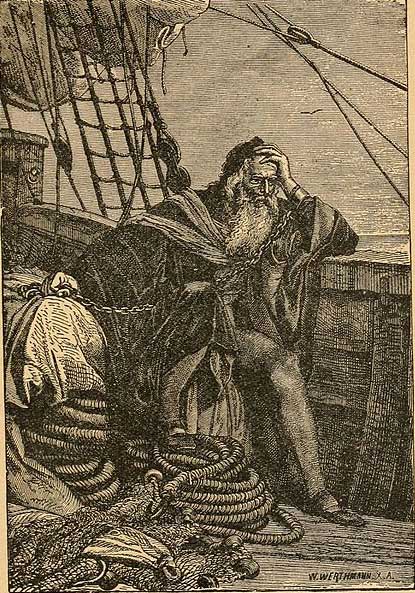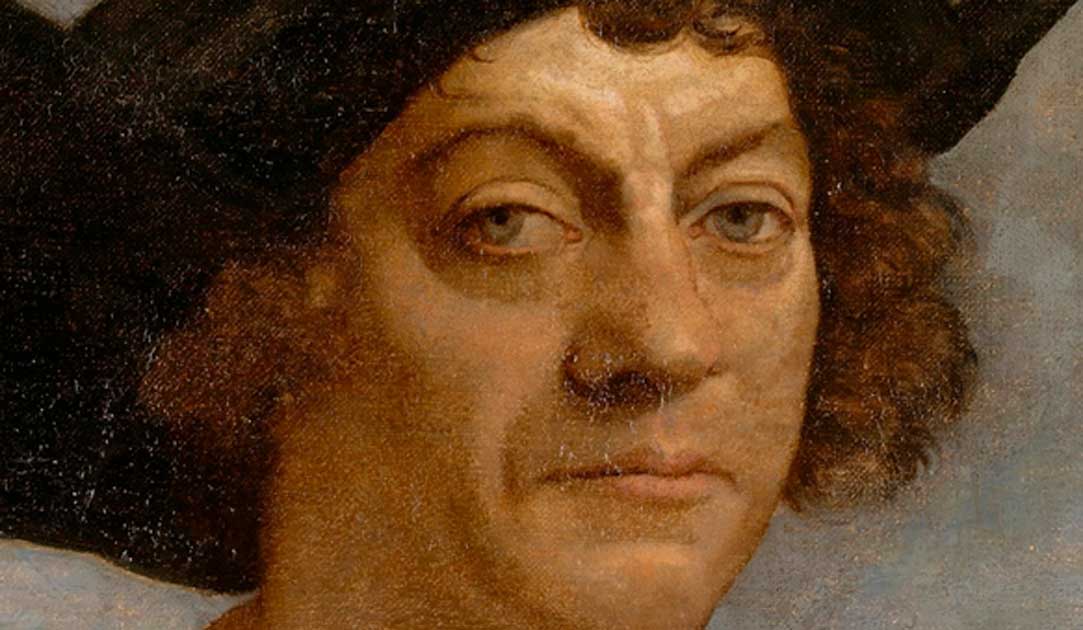How Columbus, Of All People, Became a National Symbol
Christopher Columbus was a narcissist. He believed he was personally chosen by God for a mission that no one else could achieve. After 1493, he signed his name “xpo ferens” – “the Christbearer.” His stated goal was to accumulate enough wealth to recapture Jerusalem. His arrogance led to his downfall, that of millions of Native Americans – and eventually fostered his resurrection as the most enduring icon of the Americas.
Columbus in chains
In 1496, Columbus was the governor of a colony based at Santo Domingo, in what is now the modern Dominican Republic – a job he hated. He could not convince the other “colonists,” especially those with noble titles, to follow his leadership.
They were not colonists in the traditional sense of the word. They had gone to the Indies to get rich quick. Because Columbus was unable to temper their lust, the Crown viewed him as an incompetent administrator. The colony was largely a social and economic failure. The wealth that Columbus promised the Spanish monarchs failed to materialize, and he made continuous requests for additional financial support, which the monarchs reluctantly provided.
By 1500, conditions in Hispaniola were so dire that the Crown sent Francisco de Bobadilla to investigate. Bobadilla’s first sight, at the mouth of the Ozama River, was four Spanish “mutineers” hanging from gallows. Under authority from the king, Bobadilla arrested Columbus and his brothers for malfeasance and sent them to Spain in chains. Columbus waited seven months for an audience at the court. He refused to have his chains removed until the meeting, and even asked in his will to be buried with the chains.
Although the Spanish rulers wanted Columbus to disappear, he was allowed one final voyage from 1502 to 1504. He died in 1506, and went virtually unmentioned by historians until he was resurrected as a symbol of the United States.

Christopher Columbus in chains (public domain)
Inventing Columbus
In the mid-18th century, scholars brought to light long-forgotten documents about Columbus and the early history of the New World.
One of the most important was Bartolome de las Casas’ three-volume “Historia de las Indias.” This book was suppressed in Spain because it documented Spain’s harsh treatment of the native peoples. His depiction of Spanish mistreatment of the Indians provided the foundation for the “Black Legend.” His account “blackened” Spanish character by depicting it as repressive, brutal, intolerant and intellectually and artistically backward. Whatever Spain’s motives, the conquest of the Americas destroyed native cultures and ushered in centuries of African enslavement.
!["They would cut an Indian's hands and leave them dangling by a shred of skin ... [and] they would test their swords and their manly strength on captured Indians and place bets on the slicing off of heads or cutting of bodies in half with one blow. ... [One] cruel captain traveled over many leagues, capturing all the Indians he could find. Since the Indians would not tell him who their new lord was, he cut off the hands of some and threw others to the dogs, and thus they were torn to pieces." Included in ‘Brevísima relación de la destrucción de las Indias’, 1552 by Bartolomé de las Casas](https://www.ancient-origins.net/sites/default/files/styles/large/public/They-would-cut-an-Indians-hands.jpg?itok=a-lmVCBD)
"They would cut an Indian's hands and leave them dangling by a shred of skin ... [and] they would test their swords and their manly strength on captured Indians and place bets on the slicing off of heads or cutting of bodies in half with one blow. ... [One] cruel captain traveled over many leagues, capturing all the Indians he could find. Since the Indians would not tell him who their new lord was, he cut off the hands of some and threw others to the dogs, and thus they were torn to pieces." Included in ‘Brevísima relación de la destrucción de las Indias’, 1552 by Bartolomé de las Casas (public domain)
Another was the personal journal of Christopher Columbus from his first voyage, published in 1880. The journal captured the attention of Gustavus Fox, Abraham Lincoln’s assistant secretary of the Navy, who made the first attempt to reconstruct the route of Columbus’s first voyage.
Renewed scholarly interest in Columbus coincided with political motives to deny Spain any remaining claims in the Americas. Spain’s American colonies declared independence, one by one, from the beginning of the 19th century. Simón Bolivar, and other Creole revolutionary leaders, embraced a classical philosophy that highlighted their Roman ancestry to a degree that “Spanish America” was converted to Latin America. The final assault came with the U.S. invasion of Cuba and the six-month Spanish-American War in 1898. Puerto Rico became a U.S. territory, and this year marks the 100th anniversary of the purchase of the U.S. Virgin Islands from Denmark.
Columbus likely would have slipped back into obscurity if not for American hubris.
The Columbian Exposition
In 1889, France put on what reviewers described as the most spectacular World’s Fair possible. Held on the Champs de Mars in Paris, its crowning achievement was the Eiffel Tower.

Looking West From Peristyle, Court of Honor and Grand Basin of the 1893 World’s Columbian Exposition. The Project Gutenberg EBook of Official Views of The World's Columbian Exposition
After Paris, the United States set out to prove to the world it was the equal of Europe by staging its own World’s Fair. No one has claimed credit for the theme of the Exposition, but the stage was set when American writer and author of “The Legend of Sleepy Hollow,” Washington Irving, attempted to revive his flagging career by writing the first biography of Christopher Columbus in English, published in 1828.
His embellishments created the great hero whose legend the fair celebrated: “He was one of those men of strong natural genius, who appear to form themselves; who, from having to contend at their very outset with privations and impediments, acquire an intrepidity in braving and a facility in vanquishing difficulties.”
The Columbian Exposition and World’s Fair was timed to coincide with the 400th anniversary of Columbus’s arrival in the New World. President William H. Harrison presided over opening ceremonies on Oct. 12, 1892. That same day, the Pledge of Allegiance was introduced in American schools.
Chicago created the “White City” – a collection of nine “palaces” designed by America’s greatest architects, conceived and constructed in only 26 months. Outside the White City was the grittier Midway, which is now a common feature of carnivals and fairs. The fair gave visitors their first taste of carbonated soda, Cracker Jacks and Juicy Fruit chewing gum. An enormous 264-foot-tall Ferris wheel transported 36 cars each carrying up to 60 people on a 20-minute ride. More than 28 million tickets were sold during the six months the Columbian Exposition was open. Columbus was the darling of 19th-century mass media.
Seventy-one portraits of Columbus, all posthumous, hung in a Grand Gallery. Following Irving’s descriptions, Columbus became the embodiment of the American Dream. The son of simple wool weavers and someone who had a great dream challenged the greatest scholars of his day, and boldly went where no man had gone before. Better yet, he was Italian. America could deny that Spain had any part in the discovery of the New World.

Christopher Columbus had been cast as a hero (public domain)
President Harrison declared a national holiday to coincide with opening of the Columbian Exposition – Columbus Day. It was officially recognized by Congress in 1937.
In 1992, as the United States prepared for the 500th anniversary of Columbus’s arrival in the Americas, the pendulum swung again. The devastating impact of his “discovery” on native peoples throughout the Americas led protesters to decry Columbus as a “terrorist.”
Columbus the man died more than 500 years ago. Columbus the legend is still being dismantled. His story illustrates the blurred borders between myth and history – how an architect of destruction was turned into a national symbol.
Top image: Portrait of Christopher Columbus (public domain)
The article ‘How Columbus, Of All People, Became a National Symbol’ by William Francis Keegan was originally published on The Conversation and has been republished under a Creative Commons License.



















